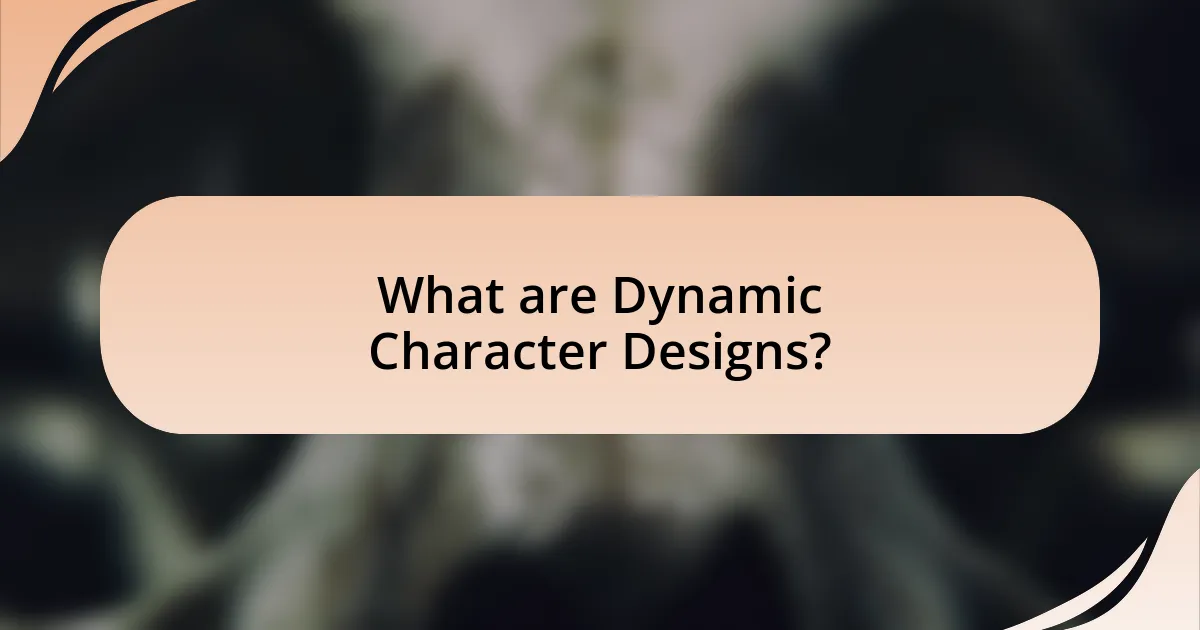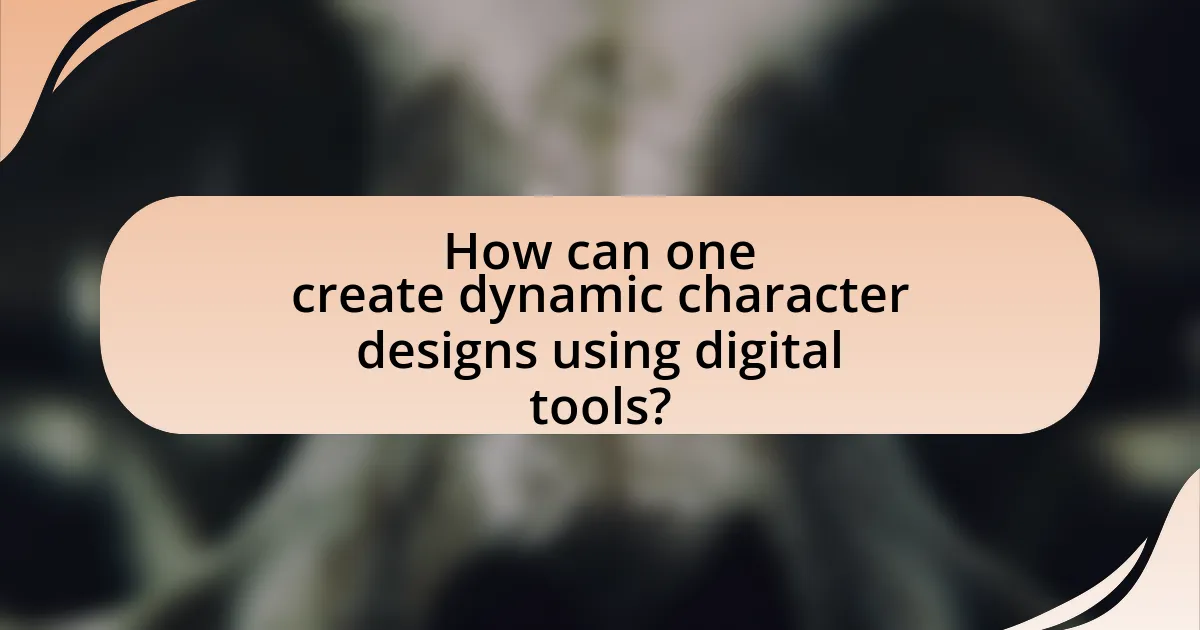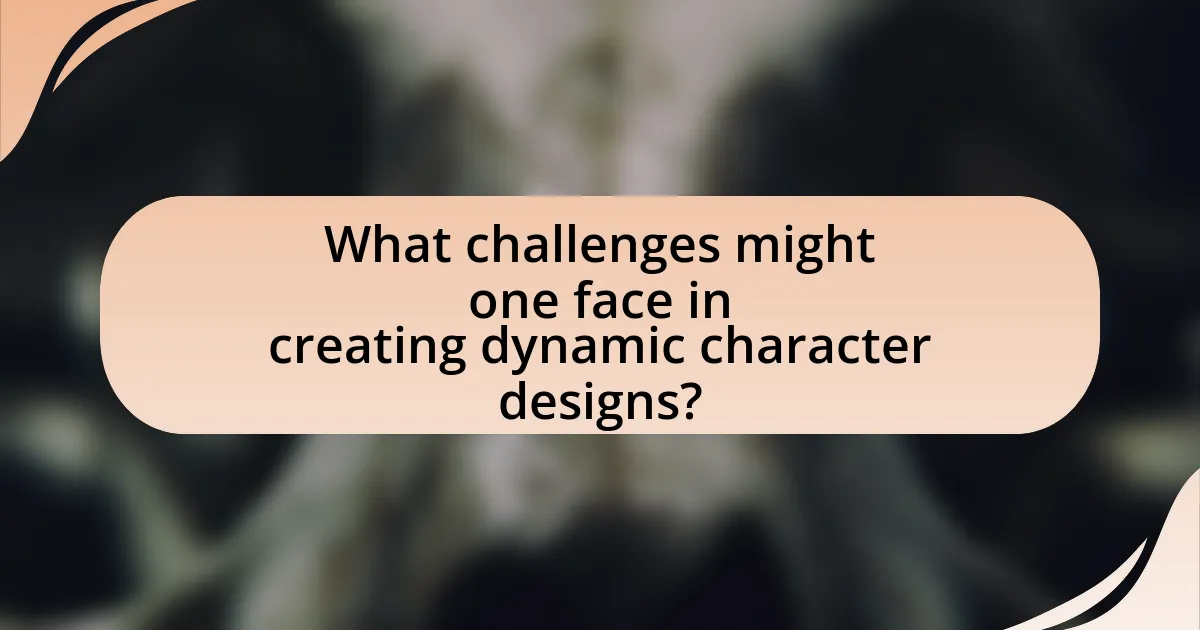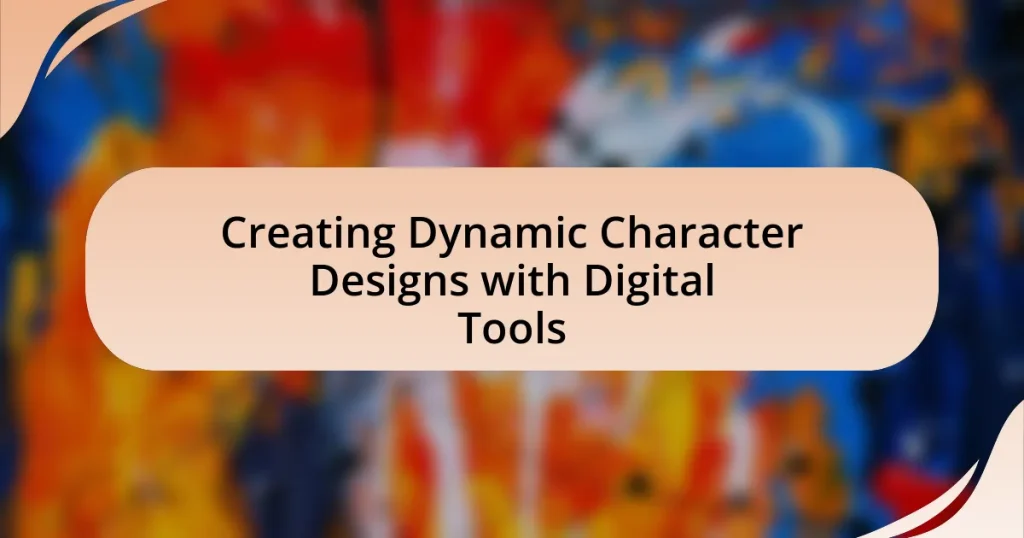Dynamic character designs are visual representations that convey movement, personality, and emotional depth, often utilized in animated films and video games to enhance storytelling. This article explores the differences between dynamic and traditional character designs, emphasizing the role of digital tools in creating adaptable and expressive characters. Key elements such as movement, color, shape, and expression contribute to the dynamism of character designs, while techniques for refining details and best practices for using digital tools are discussed. Additionally, the article addresses challenges faced in character design and offers resources and practical tips for aspiring designers to create engaging and memorable characters.

What are Dynamic Character Designs?
Dynamic character designs are visual representations of characters that exhibit a sense of movement, personality, and emotional depth. These designs often incorporate exaggerated features, varied poses, and distinct color palettes to convey the character’s traits and story effectively. For instance, animated films and video games frequently utilize dynamic character designs to engage audiences and enhance storytelling, as seen in characters from franchises like Pixar and Nintendo, where each character’s design reflects their unique attributes and roles within the narrative.
How do dynamic character designs differ from traditional designs?
Dynamic character designs differ from traditional designs primarily in their adaptability and expressiveness. Dynamic designs utilize digital tools to create characters that can easily change poses, expressions, and even styles, allowing for a more fluid representation in various contexts, such as animation or interactive media. In contrast, traditional designs often rely on static images that may not convey the same level of movement or emotion. For example, digital character rigs can be manipulated in real-time, enabling animators to produce more lifelike and responsive characters, which is a significant advancement over the fixed nature of traditional hand-drawn designs. This capability enhances storytelling by allowing characters to react dynamically to their environments and situations, thereby engaging audiences more effectively.
What elements contribute to the dynamism in character designs?
Dynamic character designs are influenced by elements such as movement, color, shape, and expression. Movement is crucial as it conveys action and energy, making characters feel alive; for instance, exaggerated poses can suggest a character’s personality or emotional state. Color plays a significant role in evoking emotions and setting the tone, with vibrant hues often associated with excitement and darker shades conveying seriousness. Shape contributes to the visual appeal and can indicate traits; for example, rounded shapes may suggest friendliness, while sharp angles can imply danger or aggression. Lastly, facial expressions are vital for conveying emotions and reactions, enhancing relatability and engagement. These elements collectively create a sense of dynamism, making characters more compelling and memorable in various media.
Why is movement important in character design?
Movement is important in character design because it conveys personality, emotion, and action, making characters more relatable and engaging. Dynamic poses and gestures can communicate a character’s intentions and feelings instantly, enhancing storytelling. For instance, a character in a dynamic running pose suggests urgency and energy, while a slouched posture may indicate sadness or defeat. Research in animation and design emphasizes that characters with clear movement are more memorable and can evoke stronger emotional responses from the audience, as seen in successful animated films where character movement plays a crucial role in audience connection.
What role do digital tools play in character design?
Digital tools are essential in character design as they enhance creativity, streamline workflows, and facilitate precise detailing. These tools, such as graphic tablets and software like Adobe Photoshop and Blender, allow artists to experiment with colors, shapes, and textures efficiently. For instance, the use of layers in digital art enables designers to make adjustments without affecting the entire composition, promoting flexibility and innovation. Additionally, digital tools support 3D modeling, which provides a comprehensive view of characters from multiple angles, improving the overall design process. The integration of these technologies has revolutionized character design, making it more accessible and versatile for artists across various industries.
Which digital tools are most commonly used for character design?
The most commonly used digital tools for character design include Adobe Photoshop, Adobe Illustrator, Clip Studio Paint, and Procreate. Adobe Photoshop is widely recognized for its robust painting and editing capabilities, making it a staple among character designers. Adobe Illustrator is favored for its vector graphics, allowing for scalable designs. Clip Studio Paint is specifically tailored for comic and manga artists, offering features that enhance character creation. Procreate is popular among digital artists for its intuitive interface and powerful brush engine, particularly on the iPad. These tools are essential in the industry, as they provide artists with the flexibility and functionality needed to create detailed and dynamic character designs.
How do these tools enhance the creative process?
Digital tools enhance the creative process by providing artists with advanced functionalities that streamline design and foster innovation. These tools, such as graphic design software and 3D modeling applications, allow for rapid prototyping, enabling creators to experiment with various styles and concepts efficiently. For instance, software like Adobe Photoshop offers layers and filters that facilitate intricate detailing and adjustments, while programs like Blender enable the visualization of characters in three dimensions, enhancing the depth and realism of designs. The integration of these technologies not only accelerates the workflow but also encourages exploration and iteration, leading to more refined and dynamic character designs.

How can one create dynamic character designs using digital tools?
To create dynamic character designs using digital tools, one should utilize software like Adobe Photoshop, Clip Studio Paint, or Procreate, which offer versatile features for illustration and animation. These tools allow artists to experiment with various styles, colors, and textures, enabling the creation of unique and engaging characters. For instance, using layers in Photoshop facilitates the manipulation of different design elements without losing previous work, while Procreate’s brush customization options enhance the artistic expression. Additionally, incorporating 3D modeling software such as Blender can provide depth and perspective, making character designs more dynamic. This approach is supported by the fact that many professional character designers leverage these digital tools to streamline their workflow and enhance creativity, as evidenced by industry practices in animation and gaming.
What are the steps involved in creating a character design?
The steps involved in creating a character design include concept development, sketching, refining the design, adding color, and finalizing the character. Concept development involves brainstorming ideas and defining the character’s personality, background, and role. Sketching translates these ideas into visual form, allowing for exploration of different poses and features. Refining the design focuses on selecting the best elements from sketches and improving details for clarity and appeal. Adding color enhances the character’s visual impact and can convey emotions or themes. Finally, finalizing the character involves creating a polished version, often including multiple views and expressions to showcase the character comprehensively. Each step is essential for producing a well-rounded and engaging character design.
How do you start with concept sketches?
To start with concept sketches, begin by gathering reference materials and brainstorming ideas related to the character you want to design. This initial phase involves sketching rough outlines and shapes to explore different poses, expressions, and features. Research indicates that artists often utilize mood boards and visual references to inspire their sketches, which can enhance creativity and direction. By focusing on the character’s personality and story, you can create sketches that effectively convey their essence, leading to more dynamic designs.
What techniques are used for refining character details?
Techniques used for refining character details include iterative sketching, color studies, and texture application. Iterative sketching allows artists to explore multiple variations of a character design, enhancing features and proportions based on feedback and observation. Color studies help in determining the character’s palette, influencing mood and personality, while texture application adds depth and realism to the design. These methods are widely recognized in character design practices, as they facilitate a more nuanced and polished final product.
What are the best practices for using digital tools in character design?
The best practices for using digital tools in character design include utilizing layers for organization, employing vector graphics for scalability, and leveraging brushes and textures for detail. Layers allow designers to separate different elements of a character, making it easier to edit and refine specific parts without affecting the whole design. Vector graphics provide the advantage of resizing without loss of quality, which is crucial for various applications, from concept art to final production. Additionally, using a variety of brushes and textures can enhance the visual richness of the character, adding depth and personality. These practices are supported by industry standards, as many professional artists emphasize the importance of these techniques in their workflows.
How can layering techniques improve character designs?
Layering techniques can significantly enhance character designs by allowing artists to build complex visuals through the combination of multiple elements. This method enables the separation of different aspects of a character, such as clothing, accessories, and facial features, which facilitates easier adjustments and refinements. For instance, using layers allows for the independent manipulation of colors, textures, and shadows, resulting in a more polished and dynamic appearance. Additionally, layering supports the iterative design process, enabling artists to experiment with variations without losing previous work, ultimately leading to more innovative and engaging character designs.
What tips can enhance the use of color and texture in designs?
To enhance the use of color and texture in designs, utilize a color wheel to create harmonious palettes and apply contrasting textures to add depth. The color wheel helps designers select complementary colors, which can evoke specific emotions and improve visual appeal. For instance, using warm colors like red and orange can create a sense of energy, while cool colors like blue and green can convey calmness. Additionally, incorporating various textures, such as smooth, rough, or patterned surfaces, can create visual interest and enhance the tactile quality of the design. Research indicates that texture can influence perception; for example, a study by the University of Southern California found that textured surfaces can enhance the viewer’s emotional response to visual stimuli.

What challenges might one face in creating dynamic character designs?
Creating dynamic character designs presents several challenges, including maintaining visual consistency, ensuring character relatability, and balancing originality with audience expectations. Visual consistency is crucial as characters must appear cohesive across various poses and expressions, which can be difficult to achieve, especially when using multiple digital tools that may have different rendering styles. Ensuring character relatability involves creating designs that resonate with the audience, which can be challenging when trying to innovate or push boundaries. Additionally, balancing originality with audience expectations requires designers to innovate while still adhering to familiar tropes or characteristics that audiences recognize and appreciate. These challenges necessitate a deep understanding of design principles and audience psychology to create effective and engaging character designs.
How can one overcome common obstacles in character design?
To overcome common obstacles in character design, one should utilize iterative feedback and reference materials effectively. Iterative feedback allows designers to refine their concepts based on critiques, which can lead to improved designs that resonate with audiences. Reference materials, such as anatomy guides and existing character designs, provide a foundation for understanding proportions and styles, helping to avoid common pitfalls like unrealistic features or lack of originality. Studies in design psychology indicate that iterative processes enhance creativity and problem-solving, confirming the effectiveness of these strategies in character design.
What are the typical pitfalls when using digital tools?
The typical pitfalls when using digital tools include over-reliance on software features, which can stifle creativity and lead to generic designs. Many artists may become dependent on presets and filters, resulting in a lack of originality in character designs. Additionally, poor understanding of the tools can lead to inefficient workflows, causing frustration and wasted time. For instance, a survey by the National Endowment for the Arts found that 60% of digital artists reported feeling overwhelmed by the complexity of software, which can hinder their creative process. Furthermore, neglecting traditional art skills can diminish an artist’s ability to conceptualize and execute unique designs, as digital tools should complement rather than replace foundational techniques.
How can feedback and critique improve character designs?
Feedback and critique can significantly enhance character designs by providing diverse perspectives that identify strengths and weaknesses in the design. When artists receive constructive criticism, they can refine their concepts, ensuring that the character’s visual elements align with their intended personality and narrative role. For instance, feedback can highlight inconsistencies in design elements, such as color schemes or proportions, which may not resonate with the target audience. Studies in design psychology indicate that iterative feedback loops lead to improved outcomes, as seen in the design processes of successful video games and animated films, where character designs undergo multiple revisions based on audience and peer input. This iterative process not only fosters creativity but also ensures that the final design is more engaging and effective in storytelling.
What resources are available for aspiring character designers?
Aspiring character designers can access a variety of resources, including online courses, books, software, and community forums. Online platforms like Skillshare and Udemy offer courses specifically focused on character design techniques and digital tools, allowing learners to gain practical skills from industry professionals. Books such as “Creating Characters with Personality” by Tom Bancroft provide foundational knowledge and insights into character development. Software like Adobe Photoshop and Procreate are essential tools for digital illustration, widely used in the industry for creating character designs. Additionally, community forums such as ArtStation and DeviantArt allow aspiring designers to share their work, receive feedback, and connect with other artists, fostering a collaborative learning environment.
Which online platforms offer tutorials and courses on character design?
Online platforms that offer tutorials and courses on character design include Skillshare, Udemy, and Coursera. Skillshare provides a variety of classes focused on character design techniques and software, while Udemy features comprehensive courses that cover both fundamentals and advanced skills in character creation. Coursera partners with universities to offer structured programs that delve into character design within broader art and animation courses. These platforms are widely recognized for their educational content and user-friendly interfaces, making them accessible for learners at all levels.
How can community engagement enhance learning in character design?
Community engagement enhances learning in character design by providing collaborative opportunities that foster creativity and skill development. Engaging with a community allows aspiring character designers to receive diverse feedback, share techniques, and gain insights from experienced professionals. For instance, participation in online forums or local workshops can lead to constructive critiques that refine design skills and broaden artistic perspectives. Research indicates that collaborative learning environments significantly improve creative outcomes, as seen in studies where peer feedback led to higher quality designs in educational settings.
What are some practical tips for creating dynamic character designs?
To create dynamic character designs, focus on incorporating strong silhouettes, varied poses, and expressive features. Strong silhouettes ensure that characters are easily recognizable and memorable, while varied poses convey movement and personality, making the character feel alive. Expressive features, such as facial expressions and unique attributes, enhance emotional connection and depth. Research indicates that characters with distinct silhouettes and expressive designs are more engaging to audiences, as seen in successful animated films where character design plays a crucial role in storytelling.


